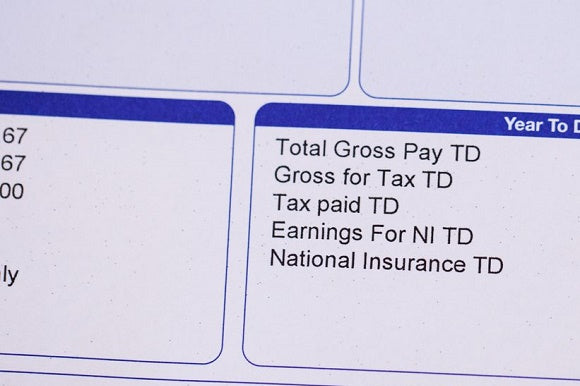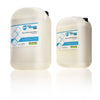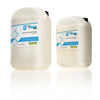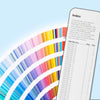Printing With Security Inks

SECURITY INKS
Non-photo / non-repro blue
Before both black and white and colour copiers were around, when a printer asked for “non-photo”or “non-repro” blue, they were referring to a light blue that was used to print paste-up sheets, boards or pre-printed forms. In the past, graphic artists had to position their designs by hand, making sure that they were positioned properly so that when they were photographed by a darkroom camera, they would be in the correct position when the negatives were stripped up by the film stripper.
Rubber cement, wax, and various other glues were used to adhere the artwork to the sheets When the paste-up sheet or board was sent to be shot on film, the darkroom camera would automatically drop the blue so that only the artwork would be picked up.
Of course, through the use of filters, the lines could be picked up, but that’s not what they wanted. They didn’t want the lines to “reproduce” or “photograph,” hence the name “non-photo blue” and “non-repro blue. You can still use these colours if you are going to use it for printing paste-up sheets, boards or pre-printed forms and you want to drop the lines. Any light shade of blue can be used. We recommend PANTONE 304. You can even mix your own by using 3%PANTONE Process Blue and 97% PANTONE Transparent White.
That was the way it used to be. Today, when a person calls and asks for a “non-photo blue” or “non-repro33blue”, more information is required. Questions need to be asked. Many times they don’t want it for paste up purposes, but want to print something that someone else cannot reproduce.
If that is the case, there is none. With the new colour copiers, even the lightest blue shades of colour can be reproduced. Many of the new black and white copiers have the same capability. Besides that, there are many other methods to reproduce a copy. If the customer does not want to print a grid or a pre-printed form that he/she can use for positioning purposes and drop out the blue, we suggest that they simply take the PANTONE Formula Guide and simply pick out some light shades of colour in the book. Take the actual book and try to photograph those colours. This will give you an instant answer as to what colour is the best to use.
Barcode / bank cheque inks
Printing designed to be “read” by machines rather than humans has increased dramatically over the years. More electronic scanners that can “read” printed type are used in commerce. This profitable printing is well within the capability of most small and medium-sized print shops, but some turn away these orders because of fear of the unknown. Hopefully this article will remove the mystery and reveal the opportunities.
MICR (Magnetic Ink Character Recognition) Van Son Magnetic Black
Van Son Magnetic Black ink is used for printing cheques, deposit slips and other financial documents. It contains magnetic iron-oxide particles, similar to those on magnetic tape. The printed characters are magnetised and then read by MICR equipment. Van Son Magnetic Black ink can be run on all types of sheet and cold-set web presses, both offset and letterpress. The high strength magnetic density insures reliable read-outs without applying excessive ink. Van Son Magnetic Black ink is formulated for best results with uncoated papers normally used to be sorted electronically by MICR equipment. The characters to be read must be of the common languageE-13B style adopted by the American Bankers Association or CMC7 in Europe
Van Son Magnetic Black ink can be run on all types of paper, plastic and metal plates. It is frequently used with Electrostatic Plates when printing short runs of individual personal checks. Use a fountain solution recommended for the particular plate system you are using. (We do not recommend using electrostatic plates or fountain solutions if printing is destined to be run through a laser printer or high speed copier). Van Son Magnetic Black ink can be left on the press overnight with the aid of an anti-skinning spray, although good printing practice is to wash the press up each night. Van Son Magnetic Black ink can also be used if finished printing is to be run through a laser printer or high speed copier. Full curing time, however, could take from 2 - 3 weeks.
Tips and precautions
When printing by offset, whenever possible, print the whole check or deposit slip with the Van Son Magnetic ink, not just the number codes. This does the job in one press pass and speeds up the exchange of ink on the press rollers preventing the ink from becoming water-logged. It also insures that the MICR number is registered exactly in the correct place.
We recommend that you stir magnetic ink before putting it on press. Van Son Magnetic Black will not plug up the type when printing with letterpress or magnetic character numbering machines.
You should avoid over-inking and too much impression squeeze to prevent bead edges from forming on the letterpress type. Van Son Magnetic Black will provide plenty of magnetic signal strength at normal ink-film thickness.
Important things to remember about printing MICR forms.
- Numbers must be printed in correct place.
- Numbers must be printed in the correct size
- Numbers must be printed clean and sharp.
OCR (Optical Character Recognition)
OCR inks are used to print bar codes, labels, lottery tickets, forms and any document designed to be processed by optical scanning. These devices which have become part of practically every business are capable of doing an incredible number of dull, error-prone, repetitive tasks with the speed of light. There are two types of OCR Inks.
Readable and non-readable OCR ink
Readable OCR inks can be detected or “seen” by the scanning device. Any carbon black ink will do. Coloured inks that contain at least 3-5% carbon black depending on the OCR Scanner used, will also work.
Don’t be fooled. Dark colours, although they may appear to be dark enough to be picked up by an OCR scanner, will not, unless they contain at least 3% to 5% carbon black. The bar-code or printing should be done on white or at least light coloured paper to provide sufficient contrast.
The check-out counter of your supermarket probably has OCR laser readers that not only correctly price items in the blink of an eye, but prints the name of the item on your sales receipt. This keeps track of store inventory for each item and alerts the store manager that he is out of an item.
Non-readable OCR inks are formulated to absorb some energy in the 400-700 nanometer range of the visible spectrum to produce a colour, but not to absorb any energy in the 900 region so the scanner reads it the same as the paper. No special equipment is required of the printer, just the right ink.
Need to replenish your Process Ink or Litho Print Supplies?
We supply a full range of Print Consumables, including Van Son Process Inks, Standard Pantone Ink, Pantone Matching Guides, Litho Print Chemistry, Litho Printing Blankets and OverPrint Varnishes.
- Clive Harper






